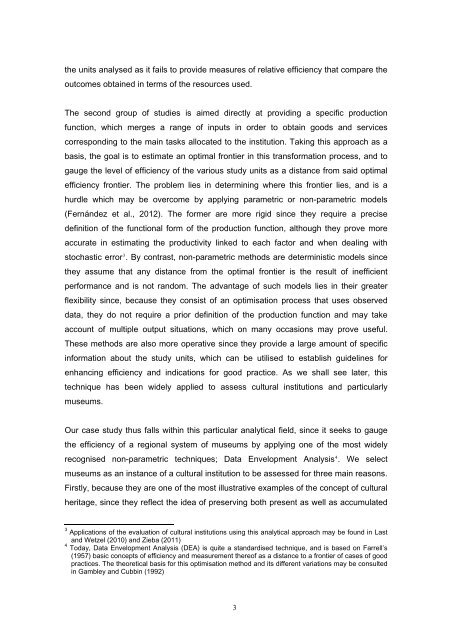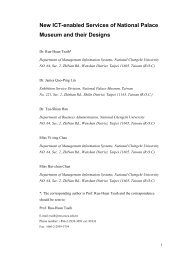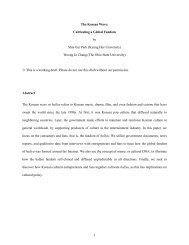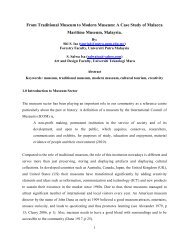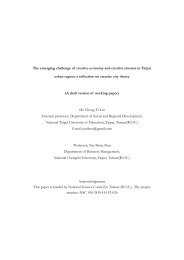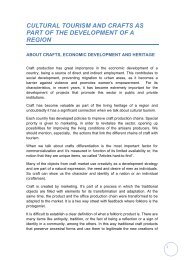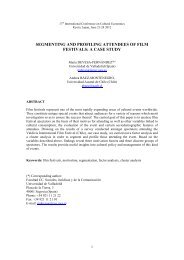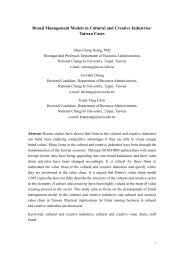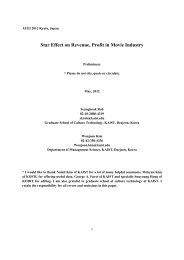Evaluating the efficiency of museums using multiple outputs
Evaluating the efficiency of museums using multiple outputs
Evaluating the efficiency of museums using multiple outputs
You also want an ePaper? Increase the reach of your titles
YUMPU automatically turns print PDFs into web optimized ePapers that Google loves.
<strong>the</strong> units analysed as it fails to provide measures <strong>of</strong> relative <strong>efficiency</strong> that compare <strong>the</strong><br />
outcomes obtained in terms <strong>of</strong> <strong>the</strong> resources used.<br />
The second group <strong>of</strong> studies is aimed directly at providing a specific production<br />
function, which merges a range <strong>of</strong> inputs in order to obtain goods and services<br />
corresponding to <strong>the</strong> main tasks allocated to <strong>the</strong> institution. Taking this approach as a<br />
basis, <strong>the</strong> goal is to estimate an optimal frontier in this transformation process, and to<br />
gauge <strong>the</strong> level <strong>of</strong> <strong>efficiency</strong> <strong>of</strong> <strong>the</strong> various study units as a distance from said optimal<br />
<strong>efficiency</strong> frontier. The problem lies in determining where this frontier lies, and is a<br />
hurdle which may be overcome by applying parametric or non-parametric models<br />
(Fernández et al., 2012). The former are more rigid since <strong>the</strong>y require a precise<br />
definition <strong>of</strong> <strong>the</strong> functional form <strong>of</strong> <strong>the</strong> production function, although <strong>the</strong>y prove more<br />
accurate in estimating <strong>the</strong> productivity linked to each factor and when dealing with<br />
stochastic error 3 . By contrast, non-parametric methods are deterministic models since<br />
<strong>the</strong>y assume that any distance from <strong>the</strong> optimal frontier is <strong>the</strong> result <strong>of</strong> inefficient<br />
performance and is not random. The advantage <strong>of</strong> such models lies in <strong>the</strong>ir greater<br />
flexibility since, because <strong>the</strong>y consist <strong>of</strong> an optimisation process that uses observed<br />
data, <strong>the</strong>y do not require a prior definition <strong>of</strong> <strong>the</strong> production function and may take<br />
account <strong>of</strong> <strong>multiple</strong> output situations, which on many occasions may prove useful.<br />
These methods are also more operative since <strong>the</strong>y provide a large amount <strong>of</strong> specific<br />
information about <strong>the</strong> study units, which can be utilised to establish guidelines for<br />
enhancing <strong>efficiency</strong> and indications for good practice. As we shall see later, this<br />
technique has been widely applied to assess cultural institutions and particularly<br />
<strong>museums</strong>.<br />
Our case study thus falls within this particular analytical field, since it seeks to gauge<br />
<strong>the</strong> <strong>efficiency</strong> <strong>of</strong> a regional system <strong>of</strong> <strong>museums</strong> by applying one <strong>of</strong> <strong>the</strong> most widely<br />
recognised non-parametric techniques; Data Envelopment Analysis 4 . We select<br />
<strong>museums</strong> as an instance <strong>of</strong> a cultural institution to be assessed for three main reasons.<br />
Firstly, because <strong>the</strong>y are one <strong>of</strong> <strong>the</strong> most illustrative examples <strong>of</strong> <strong>the</strong> concept <strong>of</strong> cultural<br />
heritage, since <strong>the</strong>y reflect <strong>the</strong> idea <strong>of</strong> preserving both present as well as accumulated<br />
3 Applications <strong>of</strong> <strong>the</strong> evaluation <strong>of</strong> cultural institutions <strong>using</strong> this analytical approach may be found in Last<br />
and Wetzel (2010) and Zieba (2011)<br />
4 Today, Data Envelopment Analysis (DEA) is quite a standardised technique, and is based on Farrell’s<br />
(1957) basic concepts <strong>of</strong> <strong>efficiency</strong> and measurement <strong>the</strong>re<strong>of</strong> as a distance to a frontier <strong>of</strong> cases <strong>of</strong> good<br />
practices. The <strong>the</strong>oretical basis for this optimisation method and its different variations may be consulted<br />
in Gambley and Cubbin (1992)<br />
3


